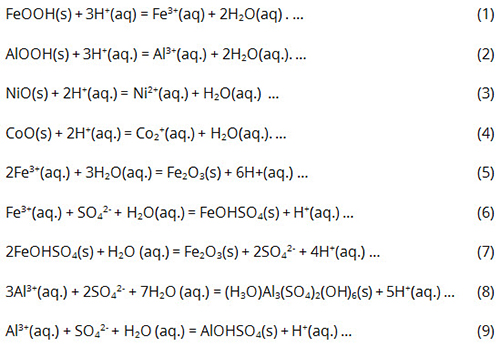The HPAL Process
High pressure acid leaching is becoming more and more important and the inevitable strain on natural resources continues.
Its primary purpose is the assist in the recovery of nickel from lacerite ores but can also be used for other metals such as copper and cobalt.
The economic recovery of nickel from laterite ores has been pronounced for some years and will become more critical in the future, as lateritic ores constitute most of the world’s known nickel and cobalt resources, with nickel production from sulphide deposits progressively decreasing. High-pressure acid leaching (HPAL) is being used for the recovery of nickel from nickel laterite ores, and increasingly atmospheric leaching is also being considered.
As mentioned above, major reserves of nickel are contained in laterite ores, which have traditionally been treated by pyrometallurgical methods. Hydrometallurgical treatment, by direct acid leaching of the ore at temperatures above 240°C, is however an alternative treatment option for several new projects. The basic steps in the process are as follows:

There are a number of possible variations to the above basic flowsheet. Other metals, such as copper and cobalt, can also be recovered by HPAL.
On the other hand, the HPAL process is used more commonly for limonitic ores with high iron, containing low magnesium and silica. The process starts with crushing, followed by screening. In this step, it is commonly evaluated if the ore can be concentrated (beneficiated) by screening, where the enriched-silica fraction is separated from the ore.
The product from the beneficiation step is fed to the autoclave. Sulfuric acid leaching of limonite is performed at high temperatures (240-270°C) in acid resistant titanium lined autoclaves. At this temperature, equilibrium vapor pressure reaches 33-35 atm. Typical operating parameters for autoclave leaching are: pulp density of 25-35% solids, 30-90 minutes residence time, 246°C to 270°C, 200-520 kg/t of acid consumption per dry ore and 3800-5400 kPa pressure.
Iron (in the trivalent state) and aluminum follow a dissolution-precipitation path, forming solid products. Iron in the form of goethite (α FeOOH) and aluminum in the form of boehmite (AlOOH) dissolve initially to soluble ferric and aluminum sulfates respectively, according to equations (1) and (2). Gibbsite (Al(OH)3), the major aluminium phase in the limonite ore, is transformed to boehmite at around 135-155°C. Nickel and cobalt in the assumed form of oxides, dissolve according to the reactions (3) and (4) respectively and remain in the aqueous phase as sulfates.

Ferric cations hydrolyze after the dissolution of goethite, forming hematite or basic ferric sulfate, as indicated by the reaction (5) and (6). Basic ferric sulfates transform to hematite (7). Basic ferric sulfates formation depends on leaching conditions and it is favored by highly acidic environment. Higher temperature, on the other hand, favors the formation of hematite.
These reactions regenerate the acid consumed by goethite dissolution, which is one of the important advantages of the HPAL process. Aluminum cations also hydrolyze, leading to the formation of solid products. Again, most of the acid consumed by boehmite dissolution is regenerated, as shown in equations (8) and (9). The autoclave product is a hot slurry, typically at 20-25% solids, containing typically 4-6 g/l nickel, 30-60 g/l sulfuric acid, <8 g/l iron and <3 g/l aluminum.
Autoclave discharge is fed to a solid/liquid separation step. Counter-current decantation is employed in most plants. It usually involves six to seven stages of thickeners. The majority of HPAL plants burn elemental sulfur to produce sulfuric acid and the by-product steam is utilized in various unit operations.

Figure 1: High Pressure Acid Leach equipment
Total Materia
Total Materia è la principale piattaforma informativa sui materiali, che fornisce le più ampie informazioni sulle proprietà dei materiali metallici e non metallici e altri dati sui materiali.
Tutte queste informazioni sono disponibili in Total Materia Horizon, lo strumento di informazione e selezione dei materiali per eccellenza, che offre un accesso impareggiabile a oltre 540.000 materiali e a dati di riferimento curati e aggiornati.
Il totale di Materia Horizon comprende:
- Dati completi sulle proprietà meccaniche e fisiche
- >80 standard globali e relative equivalenze
- Strumenti di precisione per il confronto e l'analisi che semplificano il processo di selezione.
- Dati di sollecitazione-deformazione, formabilità, fatica, scorrimento e frattura.
- Esportazione in oltre 25 formati CAx.
- Trattamento termico, metallografia, informazioni sulla corrosione
- Dati su saldatura, brasatura e adesivi.
- Fonti aggiornate mensilmente e tracciabili garantiscono l'affidabilità